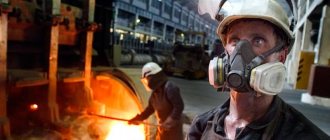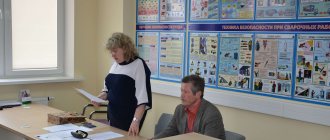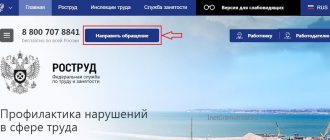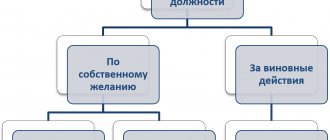What is an accident
Actions in case of an accident at work
An injury to an employee that occurs during the performance of production tasks, no matter what the degree, is considered an accident that occurred at work. Based on the results of the injury, an investigation is being conducted by a special commission. This circumstance can affect any person and many people raise the question: “What to do and where to go next?”
For example, if an incident occurred on the employer’s premises and the employee was not performing work related to his main duties, or the incident occurred on the way to work, do these facts need to be investigated? All accidents without exception are subject to investigation; this is directly stated in legislative acts, and concealment of circumstances is punishable by law.
The employee is obliged:
- Report to the manager, and if he is not able to personally communicate with management, then it is necessary to involve witnesses.
- The place where the accident occurred should be left unchanged if this does not threaten the further development of undesirable events, which could lead to other serious consequences.
- Write an explanation of why this incident occurred.
The manager is obliged:
- immediately respond to the incident: inform senior management and an occupational safety specialist and organize the provision of medical care;
- secure the scene of the incident for investigation by the commission.
The manager at whose site the accident occurred is not included in the investigation commission.
Types of accidents
Accidents can be of different types depending on the severity, durability and extent of injury.
An accident that results in death or permanent or long-term disability of the injured worker is called a serious accident.
A cut that does not disable the worker is called a minor accident . When a worker suffers an injury with external signs, it is an external injury.
An injury without external signs, such as a broken bone, is called internal. When an injury leaves an injured worker incapacitated for, say, a day or a week, it is a temporary injury.
Disability caused by an accident can be partial or total, fatal or non-fatal.
No accidents happen suddenly. Instead, certain factors cause accidents.
It has been observed that an accident does not have one cause, but many causes, which are often closely related.
About the causes of accidents
Main causes of accidents at work
During investigations, the circumstances that caused the incident are clarified.
Sanitary and hygienic. The accident occurred as a result of insufficient organization of the workplace. For example, poor lighting caused injury to an employee, and increased dust levels reduced the visibility area and the person was injured.
The worker was not provided with personal protective equipment, such as safety glasses, and therefore chips got into his eye. The employee was not trained in safe work practices and did not know what to do in the current situation, so he was injured at work.
Technical. The injury occurred as a result of working on faulty equipment that did not undergo technical inspections in a timely manner and was not repaired. The work was carried out with faulty tools or safety devices were not checked in a timely manner, and technical examinations or industrial safety examinations of technical devices were not carried out in the absence of grounding on the equipment or other problems.
What is an industrial accident?
An industrial accident is a sudden and unexpected event at an industrial facility, technical system or industrial installation that interrupts the orderly execution of work.
An industrial accident also refers to a situation where a person is injured in an enterprise, rendering him unable to resume his duties for the next 48 hours.
In other words, an accident is an unexpected event in the course of work that is not expected and should not happen.
It is important to note that self-inflicted injuries cannot be considered accidents.
Responsibility for concealing an accident at enterprises can lead from closure to fines to criminal liability.
An occupational injury can be described as a bodily injury to a worker caused by an accident or occupational disease and arising out of or in the course of work, which may entitle the worker to compensation.
How to prevent accidents from occurring
Prevention of industrial accidents
When an employee is injured while performing a production task, it is already too late to take measures to prevent this from happening; only based on the results of the investigation, everything necessary can be done to prevent this from happening in the future. The ideal solution would be to prevent accidents from occurring. To do this you need to do the following:
- If the organization employs 50 people or more, then it is imperative to add an occupational safety specialist to the staff. There is no need to save on this, and special attention should be paid to the selection of personnel. First of all, a person must be a responsible and competent worker.
- Conduct a special assessment of working conditions, based on the results of which a workplace passport is issued. Based on this document, it will be easy to issue employees with PPE and special clothing, as well as indicate dangerous points. All issued PPE must have its own certificates and comply with GOST requirements.
- Conduct all types of briefings, and they should not be formal. A conversation with employees gives a good result, since they themselves point out weak areas in the performance of their work.
- Briefings must be carried out in a timely manner.
- Targeted checks on the operation of process equipment, during which the serviceability of interlocking devices, the presence of grounding and the integrity of additional equipment are inspected.
- Implementation of schedules for technical inspections and diagnostics of equipment used in the technological cycle. These include equipment operating under pressure, lifting mechanisms, boiler units and others.
- Monitor performance measurements of ventilation units.
- Take action if even a minor violation is detected. At a minimum, it is necessary to draw up the Order in the form established by the organization and be sure to monitor its implementation.
Actions of the commission
During the investigation, commission members carry out a number of actions necessary to establish the causes of the industrial accident:
- inspection, creation of photo, audio-video information, diagrams and location of the accident;
- drawing up a protocol for analyzing the incident;
- an investigation is underway in cooperation with emergency services;
- drawing up documentary evidence by interviewing witnesses and explanatory notes from officials;
- analysis of the circumstances that led to a terrible accident or incident, establishing a list of causes;
- analysis of the nature of technology violations and operating conditions of the facility;
- carrying out production control checks;
- analysis of standards for compliance with industrial safety conditions at energy facilities and hydraulic structures;
- analysis of compliance of the facility and technologies with design documentation;
- comparison of the legality of design decisions with their changes and implementation;
- identification of inconsistencies in the field of equipment use;
- identifying malfunctions of personnel protective equipment;
- analysis of personnel qualifications;
- checking the insurance contract regarding damage caused during work at the site;
- checking the quality of technical documentation for equipment operation;
- establishing the causes of a man-made accident and restoring the details of its development based on interviews with witnesses, analysis of documentation, expert opinions, and the results of an investigative experiment;
- identification of deviations from industrial safety standards and analysis of the behavior of persons responsible for errors;
- checking the performance of duties by the production control service;
- development of methods to eliminate the preconditions for the accident and its reoccurrence;
- preliminary determination of the amount of damage, taking into account direct losses, socio-economic losses, damage due to improperly used potential of the facility, harm caused to the environment.
An integral document for preparing for a technical investigation into the causes of an industrial accident is a calculation of economic damage, signed by the management of a structural unit.
Based on the results of the investigation, the head of the structural unit issues an order to eliminate the preconditions and consequences of the accident, introduce measures to stabilize production and bring to justice those who committed violations of the legislative and regulatory requirements of the Russian Federation.
Prevention
The prevention of accidents at work is given top priority. There is a whole complex developed based on monitoring the causes of industrial injuries. These are measures to prevent accidents at work. According to their nature and place of implementation, they are divided into:
- technical;
- organizational;
- sanitary and hygienic.
Technical measures to prevent injuries include work to modernize equipment. Excluding outdated models from the production cycle, reducing the time of human participation in difficult and dangerous stages through automation of technological processes, introducing remote control, and using personal protective equipment.
Sanitary and hygienic measures to prevent accidents. This group includes measures such as proper lighting in workplaces, creating comfortable environmental conditions in terms of temperature, humidity, dust, levels of radiation, noise and vibration factors, and maintaining proper sanitary conditions.
Organizational events. They involve training workers, conducting initial, introductory, repeated, unscheduled briefings with them, using visual propaganda, warning labels and signs, periodically carrying out scheduled preventive maintenance of equipment, lecturing on labor protection, thoroughly investigating and recording accidents, complying with the requirements of legislative acts .
To learn more about the causes and prevention of accidents, ask questions in the comments to the article
The main causes of industrial accidents
| Guiding Documents | Rostechnadzor documents | 18+ |
all articles
Articles
Publication date: 06/19/2019
In recent years, the number of accidents at work has significantly decreased in Russia. However, the problem remains serious.
Statistics from the Ministry of Labor of the Russian Federation show that compared to 2017, the number of industrial accidents leading to serious injuries decreased by more than 2 times. If 12 years ago there were 13.7 thousand, then in 2021 almost 6 thousand were recorded. At the same time, compared to 2021, last year the death toll decreased by 2%. But despite the positive dynamics, the statistics remain depressing. The highest level of injuries was recorded in construction (21% of all cases with severe consequences), manufacturing (17%), agriculture (13%) and transport (12%). Traditionally, a high risk of accidents and fatal incidents remains in the coal and mining industries - in 2021, 8% of the total number of accidents occurred here.
According to Rostechnadzor in 2021, accident and injury rates at mining sites last year decreased by 20% compared to 2021 data. There were 5 accidents at coal enterprises, the total number of fatally injured people was 17. There were 4 accidents at ore and non-metallic deposits, the total number of deaths was 56 people. As in other industries, about 70% of accidents in mines, quarries and deposits are caused by human factors. Among the reasons: non-compliance with safety regulations, low level of production control, violations of the technological process and regulations, violations in the organization of work, uncoordinated actions of employees, insufficient level of personnel training.
Experts agree that the global cause of industrial accidents and injuries lies in the fact that the Russian occupational safety and health sector remains imperfect, as it is based on a “reactive” approach. This refers to responding to accidents that have already occurred. Whereas to effectively prevent emergency situations, it is necessary to implement a preventive management model, or a preventive approach. To achieve the so-called “zero injuries”, the Ministry of Labor is actively promoting the introduction of new provisions into the Labor Code. In particular, they provide for the establishment of a procedure for the early and systematic identification of threats to the life and health of workers.
Other experts highlight a poor safety culture as a key problem. The problem is that in many enterprises very little attention is paid to discipline, and management often approaches the implementation of safety requirements formally, “for show.” Experts see one of the ways to correct the situation by enshrining at the legislative level the obligation of business owners to allocate funds to solve labor safety problems.
Returning to mining, it is worth saying that in this area the attitude towards industrial safety has changed dramatically over the past 10-20 years. Including, under the influence of tightening control on the part of Rostechnadzor. Companies in the coal and mining industries understand how dangerous and unprofitable it is to ignore the requirements that are recorded, first of all, in Rostechnadzor Order No. 599 (“Safety rules for mining and processing of solid minerals”). And this is where high-tech solutions are increasingly being used, making it possible to implement the very reactive approach that the Ministry of Labor is talking about. That is, to comprehensively engage in the prevention of emergencies and accidents, reducing the negative impact of the human factor.
As an example, we can cite the positioning systems with which all quarries, mines and open-pit mines must be equipped in accordance with paragraph 75 of Order No. 599. Modern systems provide not just remote location control, but also make it possible to analyze the actions of employees and identify irregularities in work using various software tools. Of course, this will be achieved provided that the system is highly technically equipped and includes a set of necessary equipment (positioning tags, access points, mobile voice communication devices, emergency notification equipment).
Another example of solutions to reduce human hazards in mining is collision avoidance systems. Recently, Rostekhnadzor supplemented Order No. 599 with the requirement “to ensure timely notification of the driver about the presence of people and vehicles within the radius of the machine’s trajectory.” But even before this norm was officially consolidated, corresponding developments began to be introduced at enterprises. In particular, we can mention the RealTrac system, which sets a certain industry standard in this direction. The system provides a double level of control (vehicle-vehicle, transport-person), notifies the miner, driver and operator of dangerous approaches and is guaranteed to stop collisions up to the automatic stop of equipment and working tools. The system also informs the mining dispatcher about all potentially dangerous incidents for subsequent analysis and preventing attempts to hide what happened.
As you can see, technical solutions exist to eliminate the main cause of accidents. And the most responsible enterprises are actively implementing them. However, we must remember that it will not be possible to globally overcome the problems of accidents and injuries simply by installing any equipment and programs. The problem must be solved comprehensively at all levels: organizing training and briefings, explanatory conversations, bonuses for compliance with rules and fines for ignoring them, support for rational initiatives from below. Ideally, at every production facility, all employees should achieve a level of self-control at which emergency situations are practically excluded.
.
© Timur Viktorovich Poltorykhin , General Director of RealTruck Technologies.
Latest Articles
Before and after: how business adapts to the crisis
UPS for enterprises: what can power outages lead to?
Reliable equipment is the key to high efficiency and safety of enterprises
Experience in operating industrial cranes in the field of waste disposal and recycling
Industrial safety: protection of power supply systems
other articles











